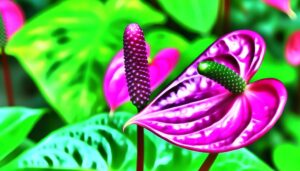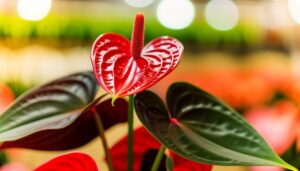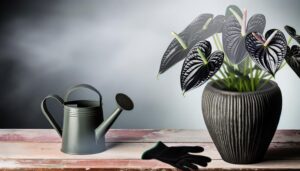Why Is the Pink Anthurium Plant Unique? Key Highlights!
The Pink Anthurium plant‘s uniqueness lies in its vibrant pink spathes, a result of anthocyanin pigments, contrasted against glossy dark green, heart-shaped leaves with a waxy cuticle layer. These features enhance photosynthetic efficiency and ecological resilience.
The interplay of colors attracts pollinators, symbolizing love and affection. Its specialized root system thrives in well-draining soil and versatile lighting conditions, making it an excellent low-maintenance indoor plant.
The plant symbolizes hospitality and abundance, conveying profound messages in living spaces. For an in-depth exploration of its anatomy and symbolism, you’re just a step away from discovering more.
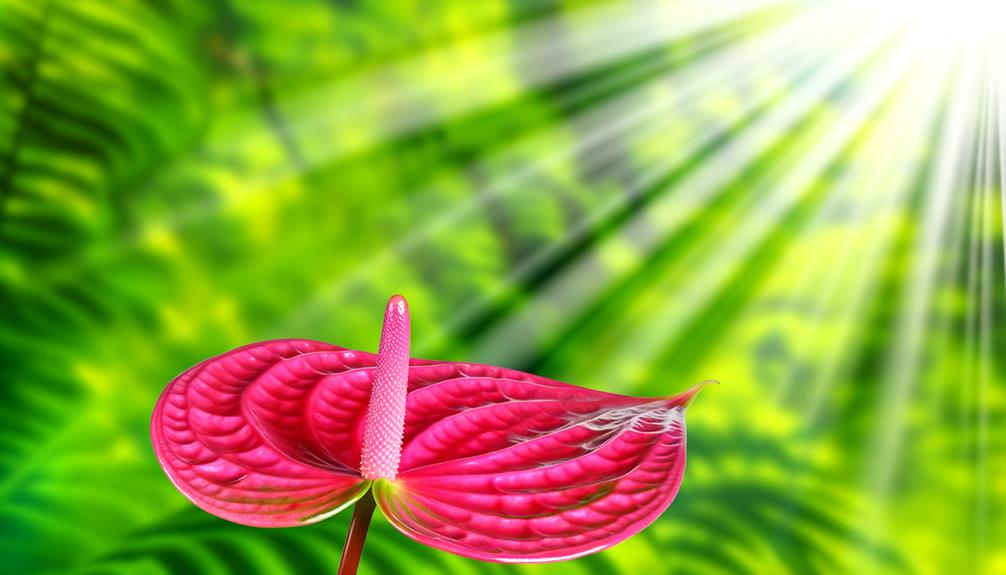
Key Takeaways
- Pink spathes are due to anthocyanin pigments, offering striking visual appeal.
- Heart-shaped, glossy leaves have a waxy cuticle that minimizes water loss.
- Symbolizes hospitality, passionate love, and prosperity, making it meaningful in various settings.
- Thrives in well-draining soil and adapts to minimal sunlight, requiring low maintenance.
- Anatomically optimized for tropical environments with efficient nutrient transport and water runoff.
Striking Visual Appeal
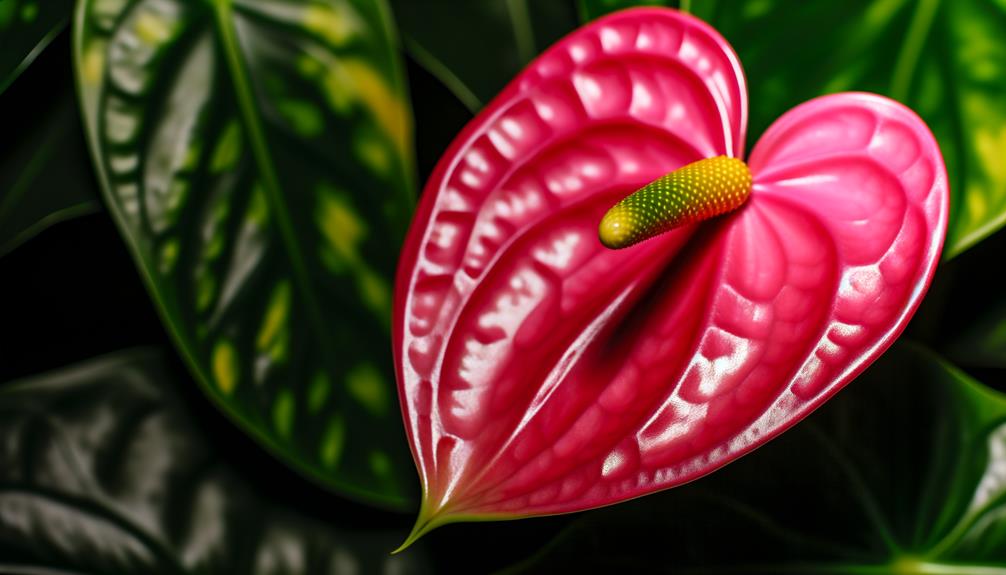
The pink anthurium plant’s striking visual appeal arises from its vibrant spathes and glossy green leaves, which create a mesmerizing contrast.
You’ll notice the spathes—modified leaves—exhibit a vivid pink hue due to anthocyanin pigments. This vibrant coloration isn’t just eye-catching but also functions in attracting pollinators.
The spathes encircle the spadix, a central column where minute flowers cluster. The glossy green leaves owe their sheen to a waxy cuticle layer, which reduces water loss and reflects light, enhancing the plant’s overall luster. These anatomical features are optimized for tropical environments, allowing the anthurium to thrive.
Heart-Shaped Leaves
You’ll notice the Anthurium’s heart-shaped leaves, which are botanically significant for their unique morphology and vibrant coloration.
The leaves’ pronounced venation creates a striking contrast against their deep green background, enhancing their visual appeal.
Additionally, these heart shapes carry natural symbolism, often associated with love and affection in various cultures.
Distinct Leaf Shape
Heart-shaped leaves of the Pink Anthurium plant, scientifically known as Anthurium andraeanum, exhibit a unique morphology that contributes to its distinctive aesthetic appeal and functional adaptation.
You’ll notice that the leaves are cordate, meaning they’re heart-shaped with a pointed apex and broad, rounded base. This morphology enhances photosynthetic efficiency by maximizing surface area exposed to light.
Additionally, the prominent veins on these leaves facilitate efficient nutrient transport and water distribution, ensuring ideal physiological function.
The waxy cuticle layer minimizes water loss, making the plant well-suited to its native tropical environments.
It’s fascinating how the distinct leaf shape not only beautifies your space but also underpins the plant’s ecological resilience and adaptability.
Vivid Color Contrast
A striking feature of the Pink Anthurium plant is its vivid color contrast, where the dark green heart-shaped leaves provide a dramatic backdrop to the vibrant, pink spathes.
This interplay between the chlorophyll-rich leaves and the anthocyanin-pigmented spathes not only enhances visual appeal but also plays a role in attracting pollinators.
The heart-shaped leaves, scientifically known as laminae cordata, are adept at maximizing photosynthesis, supporting the plant’s overall health.
To fully appreciate this unique contrast, consider these points:
- Light Exposure: Maintain moderate indirect sunlight to sustain leaf and spathe vibrancy.
- Watering: Keep soil consistently moist but not waterlogged.
- Humidity: Sustain high humidity levels to replicate tropical conditions.
- Fertilization: Use balanced, water-soluble fertilizers monthly for best growth.
Natural Symbolism
The distinctive heart-shaped leaves of the Pink Anthurium plant, often associated with love and affection, embody a rich layer of natural symbolism that extends beyond mere aesthetics.
These leaves, scientifically known as cordate, aren’t just visually appealing; they’re also biologically significant.
Their shape maximizes photosynthetic efficiency by increasing surface area, optimizing light absorption. Additionally, the curvature facilitates effective water runoff, preventing fungal infections.
As you nurture this plant, you’re not just caring for a decorative piece; you’re engaging in a symbiotic relationship that echoes themes of nourishment and protection. Each leaf serves as a reminder of nature’s intricate design, fostering a deeper connection between you and the natural world.
Vibrant Pink Spathes
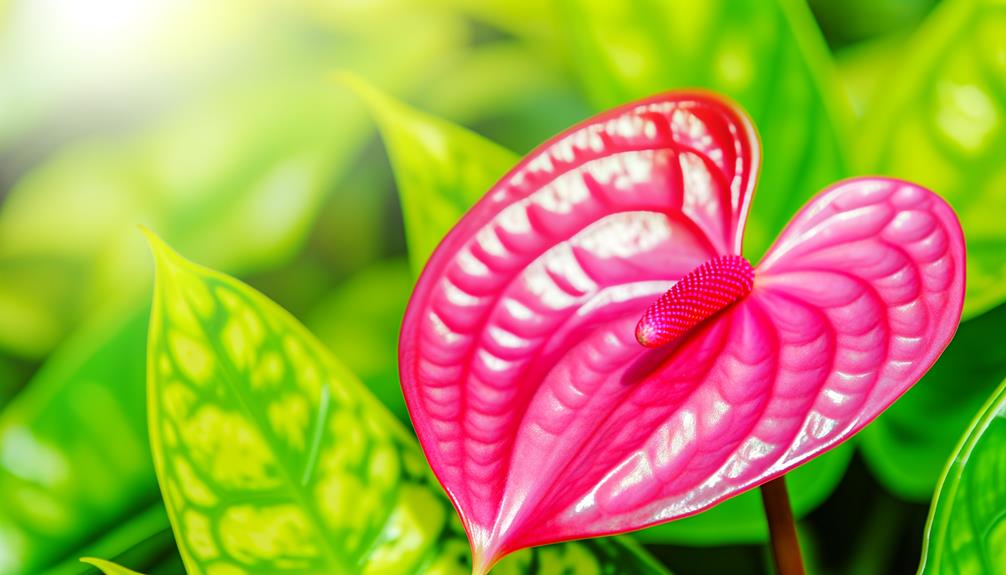
Anthurium’s vibrant pink spathes, or modified leaves, play a pivotal role in attracting pollinators and are a distinctive feature of this tropical plant. These spathes aren’t petals but specialized structures designed to allure insects and birds.
Their bright pigmentation results from anthocyanin pigments, which provide UV protection and visual appeal.
To fully appreciate these unique spathes:
- Observe their texture: The waxy surface reduces water loss and reflects light.
- Note the color intensity: Varies based on light exposure and soil pH.
- Examine the spadix: The central spike supports small, true flowers.
- Understand their function: They mimic petals to attract pollinators, ensuring reproductive success.
Long-Lasting Blooms
You’ll appreciate the Pink Anthurium’s extended flowering period, which can last up to three months per bloom cycle.
This plant’s minimal maintenance needs, such as infrequent watering and occasional fertilization, make it an efficient choice for both novice and experienced gardeners.
Extended Flowering Period
With proper care and ideal conditions, pink Anthurium plants can produce vibrant blooms that last for several weeks to months, making them a favorite among horticulturists for their extended flowering period.
To accomplish this, focus on key factors that influence the longevity of these blooms:
- Light: Provide bright, indirect sunlight. Direct exposure can cause leaf burn and reduce bloom lifespan.
- Humidity: Maintain high humidity levels, ideally between 60-80%, to mimic tropical conditions.
- Watering: Keep the soil consistently moist but not waterlogged. Overwatering can lead to root rot, while underwatering stresses the plant.
- Temperature: Guarantee a stable environment between 65-80°F (18-27°C). Temperature fluctuations can hinder flower development.
Minimal Maintenance Needs
The minimal upkeep needs of pink Anthurium plants contribute to their long-lasting blooms, making them an excellent choice for both novice and experienced gardeners.
You’ll find that they thrive in indirect light, maintaining prime photosynthetic activity without extensive care. Their semi-epiphytic nature allows them to adapt to well-draining soil, reducing root rot risks. Watering them once a week suffices, as their thick, waxy leaves minimize transpiration.
Regularly misting the foliage enhances humidity levels, fostering robust growth. Fertilize monthly with a balanced, water-soluble formula to promote nutrient availability. Pruning dead leaves and spent blooms promotes plant importance.
These practices collectively enable pink Anthuriums to yield vibrant, enduring blooms with minimal intervention, delighting any plant enthusiast.
Air-Purifying Qualities
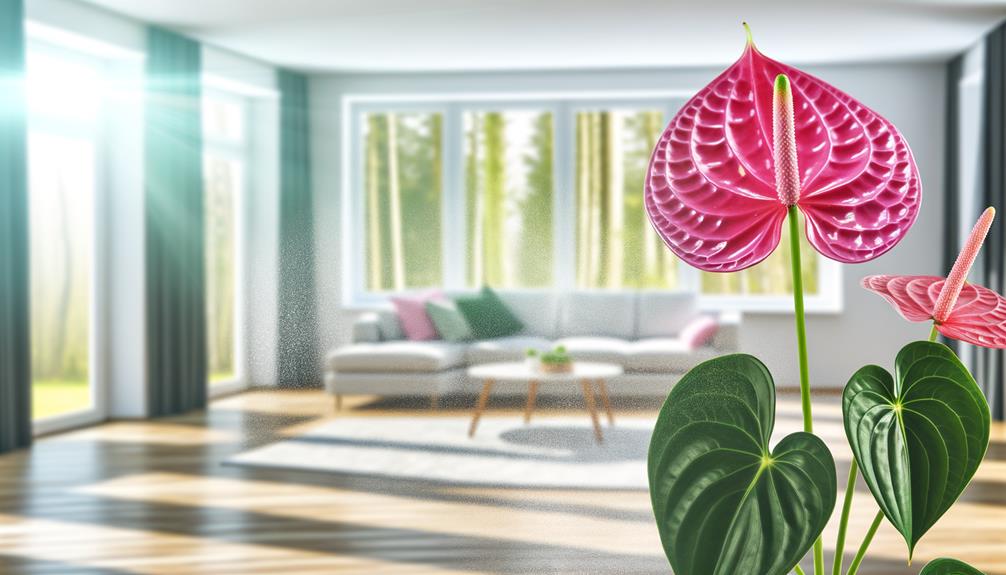
Anthurium plants, particularly the pink variety, are known for their exceptional ability to filter airborne toxins such as formaldehyde, ammonia, and xylene, greatly enhancing indoor air quality.
You’ll appreciate their ability to absorb these harmful chemicals through their large, glossy leaves, converting them into harmless compounds.
This biochemical process involves:
- Formaldehyde: Common in household products, broken down into non-toxic substances.
- Ammonia: Found in cleaning agents, neutralized effectively.
- Xylene: Present in paints and solvents, absorbed and detoxified.
- Photosynthesis: Enhances oxygen levels, contributing to a fresher environment.
Minimal Care Requirements
You’ll find the Pink Anthurium plant’s minimal care needs advantageous, as it requires infrequent watering due to its low water needs.
Its ability to thrive with minimal sunlight makes it suitable for indoor environments with indirect light.
Additionally, its easy soil preferences mean it grows well in a range of well-draining potting mixes, reducing the need for specialized substrates.
Low Water Needs
Frequently, the Pink Anthurium plant needs minimal watering, adapting well to environments with infrequent moisture.
This resilience originates from its ability to maintain cellular turgor pressure, reducing transpiration rates. You’ll appreciate this plant’s low water requirements, as it results in reduced maintenance and stress.
To optimize its hydration routine, follow these guidelines:
- Water Sparingly: Hydrate only when the top inch of soil dries out.
- Avoid Overwatering: Excessive moisture can cause root rot, compromising plant health.
- Use Well-Draining Soil: This guarantees that water doesn’t accumulate, preventing anaerobic conditions.
- Monitor Humidity: Although it’s low-maintenance, maintaining moderate ambient humidity helps in overall plant vigor.
Minimal Sunlight Required
Due to its adaptability, the Pink Anthurium plant thrives even with minimal sunlight, making it an excellent choice for low-light environments. You can place it in indirect light, where it utilizes limited photosynthetic photon flux density (PPFD) effectively.
Its chlorophyll pigments have high quantum efficiency, maximizing light absorption and energy conversion even in suboptimal conditions. This trait reduces the need for frequent adjustments to its positioning, offering you flexibility in interior design.
Additionally, the plant’s mesophyll structure allows better light diffusion, ensuring cellular respiration and growth aren’t compromised.
You’ll find that the Pink Anthurium maintains its vibrant pigmentation and robust health with just a few hours of dappled sunlight or even artificial lighting, simplifying your care routine significantly.
Easy Soil Preferences
The Pink Anthurium’s adaptability extends to its soil preferences, thriving in well-draining, nutrient-rich substrates that facilitate best root aeration and moisture retention.
You should select a potting mix that includes organic matter such as peat moss, pine bark, and perlite. This combination guarantees ideal conditions by preventing waterlogging while promoting essential nutrient uptake.
When preparing the soil mix, consider these components:
- Peat Moss: Enhances moisture retention and provides acidity.
- Pine Bark: Improves drainage and aeration, fostering root health.
- Perlite: Increases soil porosity, ensuring roots receive sufficient oxygen.
- Charcoal: Neutralizes toxins and maintains soil freshness.
With these elements, your Pink Anthurium will flourish effortlessly, reflecting your dedication to its well-being.
Versatile Indoor Plant
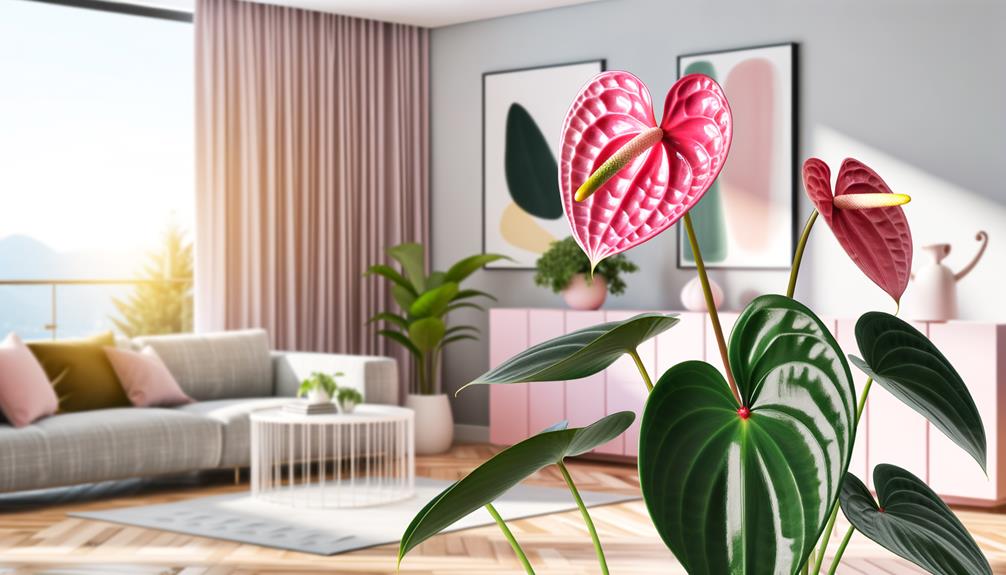
With its ability to thrive in various lighting conditions and minimal care requirements, the pink anthurium plant proves exceptionally versatile as an indoor plant.
Its robust physiology allows it to flourish under indirect light, tolerating low-light environments without significant harm to growth or flowering.
You’ll appreciate its low-maintenance nature, requiring only periodic watering when the topsoil feels dry.
Additionally, its waxy leaves exhibit high transpiration efficiency, maintaining ideal humidity levels indoors.
The anthurium’s specialized root system efficiently absorbs nutrients from well-draining substrates, reducing the need for frequent fertilization.
These characteristics ensure that incorporating this plant into your indoor space not only enhances your environment but also simplifies your plant care routine, allowing you to focus on other aspects of your life.
Symbolism and Meaning
Pink anthurium plants, often referred to as ‘flamingo flowers,’ carry deep symbolic meanings associated with hospitality, abundance, and passionate love. This symbolism stems from their striking heart-shaped spathes and vibrant hues.
By incorporating these plants into your space, you can convey nuanced messages:
Hospitality: The pink anthurium signifies a warm welcome, making it ideal for entryways.
Abundance: Its luxuriant foliage and continuous blooms symbolize prosperity and wealth.
Passionate Love: The vivid pink color represents deep romantic feelings, perfect for intimate settings.
Longevity: With proper care, the plant’s enduring blooms symbolize lasting relationships and commitments.
Understanding these meanings can help you create a more inviting and meaningful environment, enriching your living or working space.
Popular Varieties

You’ll find a diverse range of popular anthurium varieties, each boasting unique characteristics and horticultural requirements.
The Anthurium andraeanum, also known as the Flamingo Flower, features glossy, heart-shaped bracts and is distinguished by its vibrant pink spathes.
The Anthurium scherzerianum, or Painter’s Palette, exhibits a unique curly spadix and smaller, more compact growth habit.
Meanwhile, the Anthurium crystallinum is prized for its striking, velvety foliage adorned with prominent white veins, although its flowers are less noticeable.
Each variety demands specific light, humidity, and soil conditions to thrive optimally, making it essential to understand their individual needs.
Selecting the right variety depends on your aesthetic preferences and environmental compatibility, ensuring a flourishing addition to your botanical collection.
Anthurium Mini Pink
The Anthurium Mini Pink is a compact, attractive variety of the Anthurium plant, known for its small, pink, heart-shaped spathes.
It thrives in bright, indirect light and prefers well-draining soil. Keep the soil moist but not waterlogged, and maintain high humidity. Ideal for indoor decor, it adds a touch of elegance with its vibrant pink flowers and lush green foliage.
Large Pink Anthuriums
Large Pink Anthuriums are striking tropical plants known for their large, vibrant pink spathes and glossy green leaves.
They thrive in bright, indirect light and require well-draining soil. Maintain consistent moisture without waterlogging and provide high humidity for optimal growth.
These plants add a bold, exotic touch to indoor and outdoor spaces, making them popular in decorative arrangements and as statement plants. Regular feeding with a balanced fertilizer can promote healthy blooms.
Common Care Tips
Understanding the unique requirements of each anthurium variety, let’s explore foundational care tips to ensure your pink anthurium plant thrives in its environment.
- Light: Position your anthurium in indirect sunlight. Direct sunlight may scorch the leaves, while insufficient light can hinder flowering.
- Watering: Maintain consistent moisture in the soil without waterlogging. Water when the top inch of soil feels dry, ensuring proper drainage to prevent root rot.
- Humidity: Anthuriums flourish in high humidity (60-80%). Use a humidifier or place a tray of water nearby to maintain ideal conditions.
- Temperature: Keep your anthurium at temperatures between 65-80°F (18-27°C). Avoid drafts and sudden temperature changes, as these can stress the plant.
These tips will help you cultivate a healthy, vibrant pink anthurium.
Conclusion
To wrap it up, the pink anthurium plant isn’t just visually stunning with its heart-shaped leaves and vibrant pink spathes; it’s also highly functional. Its long-lasting blooms and air-purifying qualities make it a versatile indoor plant.
Symbolically rich, it represents hospitality and abundance. Popular varieties cater to diverse aesthetic preferences, while typical care suggestions guarantee longevity.
Scientifically, it’s an excellent choice for improving indoor air quality, making it a distinctive, functional, and beautiful addition to any space.


